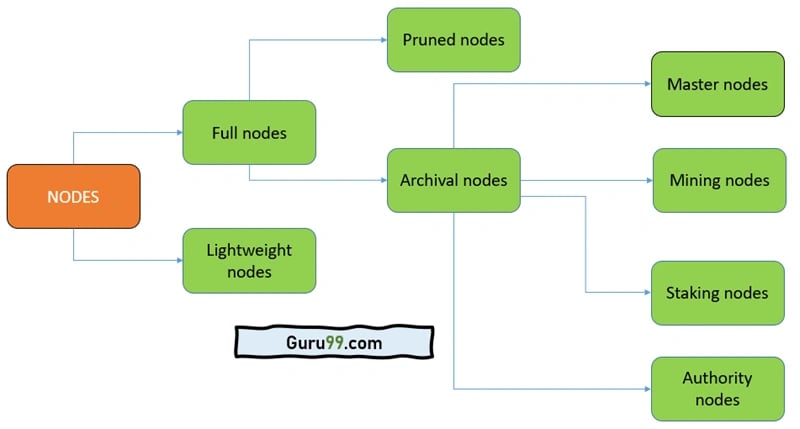Subscribe to wiki
Share wiki
Bookmark
Node
The Agent Tokenization Platform (ATP):Build autonomous agents with the Agent Development Kit (ADK)
Node
Node or blockchain node is a device, usually a computer, that participates in a blockchain network. It runs the blockchain protocol's software, allowing it to help validate transactions and keep the network secure. These nodes communicate with each other. The more nodes there are, the more decentralized the network is.[4]
Node operates as a participant in the network, contributing to the validation, propagation, and maintenance of the blockchain - the digital ledger that records all transactions. [2]
Overview
The main roles of a blockchain node are broadcasting and validating transactions. When a user submits a transaction, it’s received by a node, which broadcasts it to the rest of the network. All the nodes in the network check the transaction to make sure that the sender has the funds available and is authorized to send them.
The fact that every node verifies transactions helps secure the network. An invalid transaction could only be approved if 51% of the nodes confirmed it. In blockchain networks with hundreds or thousands of nodes, it's extremely unlikely that a bad actor would be able to take over 51%.
After new transactions are validated by the nodes, they're grouped into blocks. Each new block is added to the blockchain following the rules of its consensus mechanism, which are enforced by select nodes called full nodes.[4]
Functions
Transaction Verification
Nodes are responsible for verifying the validity of transactions before they are added to the blockchain. This verification process involves checking the cryptographic signatures and ensuring that the sender has the necessary funds to complete the transaction.
Consensus Mechanism
Nodes utilize consensus mechanisms like Proof of Work (PoW) or Proof of Stake (PoS) to collectively agree on the state of the blockchain. This agreement prevents double-spending and malicious attacks.
Maintaining the Ledger
Each node stores a copy of the entire blockchain ledger. This redundancy ensures that the data remains intact even if some nodes experience technical issues or attacks. The distribution of the ledger across multiple nodes contributes to the network's resilience and fault tolerance.
Network Propagation
When a new transaction is initiated, nodes play a critical role in relaying this information across the network. This ensures that all nodes are updated with the latest transaction data, maintaining synchronization and consistency.[3]
Types
Blockchain nodes are grouped by the functions they perform. Despite their differences, all nodes work toward maintaining the integrity of a network.[1][3][4]

Full Nodes
These nodes are the backbone of the network. They maintain a complete copy of the blockchain, participate in transaction validation, and contribute to achieving consensus. Full nodes are essential for the security and decentralization of the network.[5]
Pruned Full Node
Pruned full node is known for its set memory limit. Pruning begins upon installation, where the node downloads a blockchain in its entirety and begins deleting all but the metadata in order to maintain sequence from its oldest blocks, retaining only the most recent entries, until capacity is reached. It does not possess a complete copy of the ledger it serves, allowing its function to prioritize security over storage.
Archival Full Node
Archival full nodes store the entire blockchain ledger, recording all transactions up to its genesis block.
Master Node
Masternodes are full nodes that do not have the ability to add new blocks to the chain. Master nodes validate transactions and maintain records. These nodes also stabilise and secure the entire ecosystem and offer services such as private transactions, instant transactions, treasury management and funding and governance voting.
Dash was the first blockchain to use masternodes in its network mechanism in 2014.
Miner Nodes
In PoW-based networks, miner nodes solve complex mathematical puzzles to add new blocks to the blockchain. They compete to find the solution first and are rewarded with cryptocurrency tokens and transaction fees. Miner nodes play a vital role in securing the network and processing transactions.
Bitcoin miners actively look for new blocks to add to the network. They gain rewards with new block additions.[6]
Authority Nodes
Authority nodes are elected by a community to act as moderators of a private or partially centralized blockchain.
Staking Nodes
These nodes use a method known as 'staking' in their authentication process. Using locked funds as collateral, a proof-of-stake consensus model randomly designates authentication powers to participants who have met predetermined metrics, such as contributing a certain amount of tokens to the protocol or logging in a certain number of hours on a network.[6]
Lightweight Nodes (SPV Node)
SPV (Simplified Payment Verification) nodes are designed for resource-constrained environments like mobile devices, lightweight nodes don't store the entire blockchain. Instead, they rely on full nodes to verify transactions and provide proof that a transaction is included in a block without storing the entire block itself.
Lightning Nodes
To counteract network congestion, lightning nodes execute transactions off-chain through separate, out-of-network connections. Once processed, the transactions are added to the main blockchain. This workaround makes for low-cost, instantaneous exchanges while reducing the load on the network.
Super Nodes
Super nodes are created on demand to perform specialized tasks, such as implementing protocol changes or maintaining protocols. It transmits blockchain transaction data and additional historical information.
The Bitcoin node has a supernode that all node hosts can view.[6][7]
Responsibilities
Decentralization
Nodes eliminate the need for a central authority by distributing control across the network. This decentralization increases security, prevents single points of failure, and enhances trust in the system.
Censorship Resistance
Due to their distributed nature, nodes make censorship challenging. Even if some nodes are compromised, the network can continue to operate as long as a significant number of nodes remain honest and operational.
Security
The collaborative efforts of nodes in validating transactions and achieving consensus enhance the security of blockchain networks. This security is particularly crucial in financial applications, where trust is paramount.[4]
See something wrong?
The Agent Tokenization Platform (ATP):Build autonomous agents with the Agent Development Kit (ADK)
